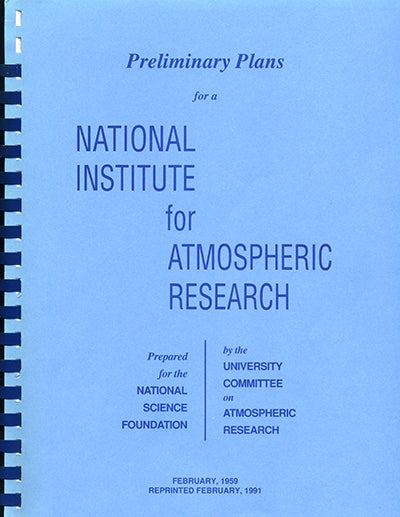The Blue Book that started it all
The 300-page document carries nearly mythical status when it comes to the organization’s history
May 18, 2010 - by Staff
May 18, 2010 - by Staff
May 25, 2010 | It’s nothing fancy—a typed, spiral-bound report from the late 1950s with a simple blue cover. But the 300-page document, nicknamed the NCAR Blue Book, carries nearly mythical status when it comes to the organization’s history.
In 1956, the National Academy of Sciences appointed a panel of eminent scientists (including Jule Charney, Carl-Gustaf Rossby, Edward Teller, and John von Neumann) to “consider and recommend means by which to increase our understanding and control of the atmosphere.”

For the next year, the committee held a series of meetings and conferences and toured university meteorology departments. After observing the dismal state of atmospheric science research in the country, the committee recommended a 50–100% boost in support for basic research, as well as the establishment of a national institute to be operated by the National Science Foundation.
Before long, a group of 14 department heads dubbed the University Committee on Atmospheric Research was planting the seeds for a National Institute for Atmospheric Research, or NIAR (which, incidentally, is “rain” spelled backwards). The committee held 17 three-day workshops to come up with a plan for NIAR, which became NCAR. The workshop notes were the foundation for Preliminary Plans for a National Institute for Atmospheric Research—also known as the Blue Book.
Today, the Blue Book lives on, and has even kept up with the times by morphing from spiral-bound notebook into an easily accessible pdf. Here are a few excerpts.
◊◊◊
“There are four compelling reasons for establishing a National Institute for Atmospheric Research:
1. The need to mount an attack on the fundamental atmospheric problems on a scale commensurate with their global nature and importance.
2. The fact that the extent of such an attack requires facilities and technological assistance beyond those that can properly be made available at individual universities.
3. The fact that the difficulties of the problems are such that they require the best talents from various disciplines to be applied to them in a coordinated fashion, on a scale not feasible in a university department.
4. The fact that such an Institute offers the possibility of preserving the natural alliance of research and education without unbalancing the university programs.”
◊◊◊
 The first meeting of UCAR’s 14 university members took place on April 2, 1959, at the University of Arizona, Tucson. A larger version of this photo, including names and affiliations, can be found in "The first 14" in UCAR Magazine.
The first meeting of UCAR’s 14 university members took place on April 2, 1959, at the University of Arizona, Tucson. A larger version of this photo, including names and affiliations, can be found in "The first 14" in UCAR Magazine.
“Major facilities at the Institute will include (1) a group of instrumented airplanes consisting of two light twin-engine planes, two medium twin-engine planes, three DC-6's and two B-57's, (2) a scientific library, (3) a large-scale transistorized electronic computer, (4) a spectroscopic laboratory, (5) microwave and optical radars, together with sferics equipment and infrared equipment for probing the atmosphere with electromagnetic radiation and (6) well-equipped electronics and machine shops.”
◊◊◊
“In terms of the level of activity now regarded as necessary to make a material contribution to the atmospheric research effort and the diversity of talent needed to do so, it appears that approximately 108 research scientists may be required in the Institute. About one half of these will have had training in the earth sciences. In the remaining half, the three major disciplines of physics, mathematics and chemistry will be represented. This degree of diversity places a relatively light burden on the existing manpower resources in any one discipline. But since the number of pre-eminent men in any field is small the recruitment of first quality scientists must proceed with careful regard for excellence.”
◊◊◊
“One of the most important tools for atmospheric research to be developed in recent years is the high-speed, large-storage electronic computer…. With the expansion in atmospheric research, and the increasing sophistication of methodology, this need is going to increase substantially…. To meet the needs of scientists at the universities and other meteorological research centers and to constitute an integral part of the research facilities at the Institute, it is essential that a computational laboratory equipped with a large-scale computer of the IBM 7090 or Philco Transac 2000 class be available at the Institute. A computer of this type….would be capable of fulfilling the immediately foreseeable needs. A staff of about forty-four people would be consistent with the estimated work load. Problems that would require an even larger computer were discussed at the research planning conferences. It was felt that arrangements to rent time on bigger computers would be the best way to take care of these occasional requirements until the demand for this scale of equipment is sufficiently great to justify purchase, construction or fulltime rental of a larger machine.”
◊◊◊
“In addition to research space, the Institute is provided with a library, an auditorium seating 550 persons, an adequate cafeteria, seminar and classrooms, space for an electronic computer, special laboratories for research in fluid mechanics, electromagnetic radiation and instrumentation, together with shops, service tunnels and the necessary administrative spaces. These features total some 215,000 square feet.”